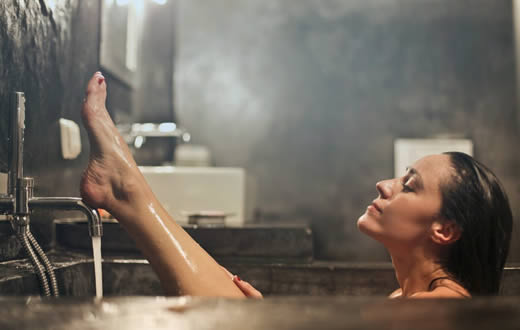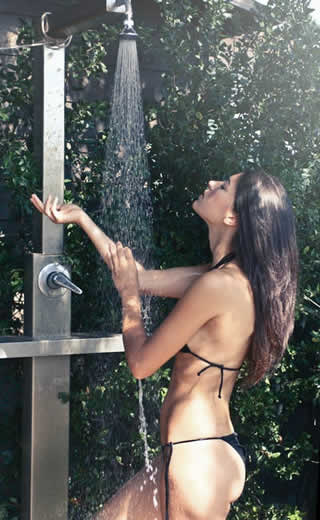Indoor Tankless Gas Water Heater Reviews for 2025
When you want a continuous supply of hot water in your home from an energy-efficient source, a gas indoor tankless water heater can provide all you need and more!
This is a technology that has been around for rather a long time. The appliances have been produced and continually improved upon for several years.
This has resulted in this most efficient and highly cost effective way to heat water.
 Tankless water heaters are made in two versions. There are models for interior installation and also models for exterior mounting outside of the house. This article focuses on the interior mounted version and the top gas-fueled models in this category.
Tankless water heaters are made in two versions. There are models for interior installation and also models for exterior mounting outside of the house. This article focuses on the interior mounted version and the top gas-fueled models in this category.
What are Tankless Water Heaters?
Simply put, these appliances are designed to heat water on demand, doing away with the need to store hot water in a tank. Water is fed into the unit where it is heated as it passes through a series of pipes and the now hot water is fed into the household hot water system and arrives at a faucet where you need it.
This is great for when you only need a small amount of hot water. For instance when taking a shower, washing your hands or face in the bathroom sink or washing up a few cups in the kitchen sink.
They are economical because they only use energy to heat the amount of water you need when you need it.
This is different from systems that store hot water in a tank. In that case, energy is used to heat a whole thankful of water whether it is used or not. Over time, heat is lost even from the best insulated tanks, so more energy is used to keep the water at the right temperature.
So you can see how much more economical an on-demand, tankless hot water system is when compared to a tank-based system.
Do I Need an Electricity Supply?
Most gas-fueled water heaters still require an electricity supply to run things like the electric spark ignition, combustion air fan and the operating controls. That's fine in most homes as most of us have electricity.
However, some homes do not have an electricity supply, such as remote cabins, off-grid homesteads etc. Fortunately, not all heaters work in this way and you can buy tankless heaters that work only with a gas supply, either natural gas piped into the home or propane in canisters.
It is important that you select the correct water heater for your needs and according to your fuel supply. Many heaters may be labeled as gas, but they may still require electricity to power the electric spark ignition and other electrical components.
Be sure to buy a heater marked as "gas only" if you do not have an electricity supply.
Indoors vs. Outdoors
Tankless water heaters made for outdoor installation are convenient because they require no venting. However, many people live in climates where temperatures can occasionally reach below freezing.
 Many on-demand water heaters are made with freeze protection. The problem is not with the appliance but often with the piping where freeze protection is not installed on exposed pipes that feed an outdoor unit.
Many on-demand water heaters are made with freeze protection. The problem is not with the appliance but often with the piping where freeze protection is not installed on exposed pipes that feed an outdoor unit.
If you live in an area where temperatures reach below freezing, an outdoor model will not generally be recommended.
Indoor gas water heaters require proper venting to expel the exhaust gases. There are two main types of indoor gas units:
- Fan assisted unit
- Atmospheric unit
The two types are explained in more detail below:
Fan Assisted Unit
Fan assisted gas water heaters can be vented either vertically through a roof or horizontally through an external wall.
These appliances use the oxygen already present in the air to produce the flame to burn. The exhaust is forced out using an internal fan. These units use special venting that will be specified in the unit's manual.
Almost all fan assisted units must use a Category III stainless steel sealed vent. This type of venting can be expensive if it is required over a large distance.
When using a fan assisted unit, a good recommendation is to try and terminate the vent as soon as possible. These models draw greater volumes of oxygen from the air and as such, they require more air to operate.
If the unit is installed in a closet or other confined space, it may lack sufficient air to operate. To install in an enclosed area, a Direct Vent (see below) model will be required.
On the other hand, a Direct Vent model is not necessarily needed if sufficient air can be accessed. This means:
- 1 square inch of access to indoor air for every 1,000 BTU
- 1 square inch of access to outside air for every 4,000BTU
For example a 200,000 BTU unit will need an open area of 200 square inches of internal space, or an area open area of 50 square inches of outside space accessible.
The same 200,000 BTU unit installed where there was only a 100 square inch area of indoor air around the water heater would not have enough and a Direct Vent model would be needed.
Atmospheric Unit
Atmospheric gas water heaters can only be vented vertically without after market equipment.
Naturally aspirated units use oxygen in the air to produce the flame to burn. The exhaust is expelled from the building via a vent flue.
These units use general venting such as B-vent that is installed in most homes.
Having the correct venting size is important. If the flue feeds into a common vent for all appliances, it is important to ensure that it is large enough to accommodate all the appliances.
Direct Vent Model
Direct vent models employ a venting system that draws in and circulates air from outside the building. The heater is fitted with a sealed cover and does not need to use air from the space it is installed in.
Two pipes extend from the water heater through an external wall or the roof of the home. One is for the exhaust gases and the other is for fresh air intake.
 This is generally achieved, depending on the model, using concentric piping (ie. a pipe within a pipe), or two individual pipes with a concentric pipe termination going through the wall or roof.
This is generally achieved, depending on the model, using concentric piping (ie. a pipe within a pipe), or two individual pipes with a concentric pipe termination going through the wall or roof.
What are the Best Models?
At this point, I want to let you in on my top recommendation for a smaller sized tankless water heater that is rapidly becoming one of the most popular brands thanks to its superior quality build, small physical size and competitive price ticket. Drum roll...
Note: As an Amazon Associate I earn from qualifying purchases.
Takagi T-KJr2-IN-NG Indoor Tankless Water Heater, Natural Gas
This high spec water heater packs a lot of high energy punch in a relatively small package. A lot of owners are already praising its virtues and giving thanks for making such a good decision to buy one!
This is a natural gas fueled tankless water heater intended for indoor installation. It's rated at 19,500 - 140,000 BTU/Hr and a 0.82 energy factor and a maximum flow rate of 6.6gpm.
That means plenty of piping hot water whenever you need it, on-demand (no hot water storage tank required).
This cost-efficient and environmental friendly model is perfect for light residential and radiant heating applications, according to the manufacturer's information.
Features at a Glance
- 140,000 BTU
- 6.6 GPM max flow rate
- 4-Inch category III stainless steel venting required
- Inlet, outlet thermistors for constant temperature monitoring
- Energy factor of 0.81-0.83
- Remote Control
- Built-in freeze protection
Here are some of the pros and cons as highlighted by some owners of this model:
Pros
- Everlasting hot water! It's the No.1 reason for choosing a tankless water heater
- You can't beat the low price!
- Handyman doable install. You need basic plumbing knowledge, but there's plenty of info on YouTube.
Cons
- There's a little time delay before the hot water reaches the faucet. Many people don't take this into consideration when they choose a water heater. It can sometimes feel like you're wasting a lot of water waiting for the shower to get hot, but it's not so much in reality.
- The BTU should be high enough to take a shower, wash clothes and someone else to wash their hands without issue. However, there is a noticeable drop in the shower water temperature when water is used elsewhere.
Do it Yourself Installation
A major concern was sealing the natural gas connections completely the first time. It needed a few tweaks to tighten the water connections. Other than those points, installation went smoothly with no problems.
It's important that the heater is installed against an outside wall and properly vented as per the instructions in the manual.
Then set the hot water to 130 degrees and enjoy endless hot water for two showers! Awesome and would recommend this or the larger unit for larger homes.
What Capacity Water Heater?
The classification of tankless water heaters is by their rated input in BTU (British Thermal Units) per hour. This is the common and most widely used form of energy measurement.
Simply put, the higher the BTU rating the greater the volume of water can be heated, or the hotter the water can be made.
To help you understand how to gauge a tankless water heater's capacity, let's look at the units it is measured in. That is to raise the temperature of water by a certain amount of degrees per flow rate.
The flow rate is generally expressed as "gpm" (gallons per minute).
Picture it like this: when you turn on the faucet in a sink, it uses about 1gpm. A regular shower uses about 2.5gpm.
Here's an example: We want to heat the water in the house to 120ºF which is roughly where it needs to be so it's really hot for washing the dishes and doing the laundry. It's quite common for ground water coming into the house to be around 50ºF.
Therefore, our heater needs to create a 70ºF rise in the water temperature (120ºF - 50ºF) to get it up to120ºF.
The first heater model featured above produces a max 6.6gpm flow rate at 140,000btu. That is easily enough for running two showers and a sink all going together and enjoying the hot 120ºF water.
Just a quick thing to note: To maintain that water temperature throughout the house, the maximum flow rate of the unit should not be exceeded, or someone will get a sudden cold shower shock!
A lot depends on the temperature of the ground water coming into the house to begin with. This is something you should verify from your local water authority which will be able to provide that information.
If you live in California, the ground water temperature is warmer at about 65ºF. So the heater wouldn't need to use as much gas to heat the water to 120ºF as it would do in say Colorado, where the ground water is only about 45ºF.
![]()


